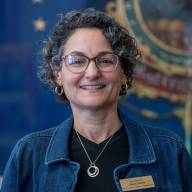Waitsfield resident Olivia Hoblitzelle’s third book will be published in March – a memoir and collection of stories called “Ley Lines of Love: Adventures Along the Spiritual Path”.
“It’s really about one person’s journey of exploring the mystery in which we live,” she said. “That mystery has been an organizing principal of my life.”
LINES OF CONNECTION
The book draws on the notion of ley lines – a term developed in early 20th century Europe to refer to the invisible alignments that connect historic structures, prehistoric sites and other landmarks. Many have argued that early societies deliberately built their most important structures along these lines.
A central theme in her book is in the invisible lines of connection among encounters, relationships and practices – all of which came to form her spiritual path over the decades. Spirituality, she said, sets a person up to explore consciousness, and binds them to the enigmas of life and death – all things Hoblitzelle has been drawn to since she was a child. “I just love the invisible,” she said.
PROFOUND SILENCE
Hoblitzelle, now in her mid-80s, has lived periodically in her Waitsfield home since 1963. She first came to The Valley after meeting her late husband Harrison Hoblitzelle –known as Hob – while she was a graduate student studying history. Years earlier, he built a small house on Common Road, which they then lived in together, adding onto the house and starting their family.
She spent much of that time working as a psychologist and meditation practitioner in Cambridge, Massachusetts. Early on, she was initiated into Transcendental Meditation, then went to practicing Zen Buddhism, often sitting in retreats with Hob. “I loved the dignity of the place, the formalities of practice, and the profound silence that permeated our days,” she wrote in her book.
From there, she practiced Vipassana – a form of insight meditation from the Theraveda tradition, which she said was the most adaptable form of meditation for Western culture at the time. One aspect of that practice, Mindfulness, came to be widely taught in schools, churches, the U.S. military, and other institutions.
INNER WORK
In 1985, she started teaching in the Mind/Body Medicine program at Massachusetts General Hospital in Boston, then trained in psychology, working in private practice. “As a psychologist, I had to do a lot of inner work before I was able to be certified to work with other people,” she said. A good deal of that work was her engagement with psychedelics, which she referred to as sacred medicines.
One of Hoblitzelle’s most power experiences was in Lincoln, Vermont, in 1977. She and her husband worked with Mexican psychiatrist Salvador Roquet, who was known for facilitating intense sensory stimulation through music and imagery while substances were taking effect. During that retreat, she had a near-death experience, which helped her to be comfortable around people who were dying, and led her to doing hospice work.
Hoblitzelle said that psychedelics, along with psychotherapy and long-term meditation practice are what helped her to overcome any fear that arises around the mysteries and uncertainties of life and death. “You can discover that there’s this place within that’s our essence, that’s totally trustworthy.”
SPIRITUAL DISILLUSIONMENT
Not all of Hoblitzelles’ spiritual journeys were pleasant. In her book she describes being involved with a yoga-focused group led by Swami Mukundananda, which she joined in 1979. After being devoted to the group for 15 years, she learned that the Swami was abusing his power in various ways. She then left, along with her daughter, who was working closely with the organization.
“Spiritual disillusionment is a really painful thing to go through,” she said. When one finds that a person engaged in healing work is also harming people – “well, how do you hold those polarities in your mind?” she asked.
She wanted to tell the story because she saw it as an archetypical one. “So many people I know got drawn to a teacher in a tradition, and then discovered some darkness about it – where the teacher was misusing power, sex, or money – and then had to leave.”
TAKING A LEAP
Hoblitzelle said that this book was a natural outgrowth of her first book “Ten Thousand Joys and Ten Thousand Sorrows: A Couples Journey through Alzheimer’s” (2010), which also catalyzed her second book “Aging with Wisdom: Reflections, Stories and Teachings” (2017).
“It’s a fascinating process, to watch how it unfolds,” she said about writing. She reflected on her chapter “Doorways to Devotion,” which poured out after asking herself the question of where her attraction to devotional practices came from to begin with. “That chapter just unfolded after I asked the question. It was like following an intuitive leap into the unknown, and seeing where it would lead. And it was very surprising where it led me,” she said.
“That’s the excitement of writing.”













